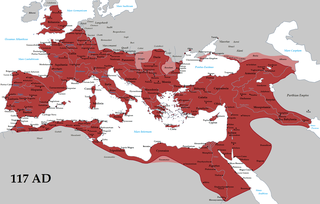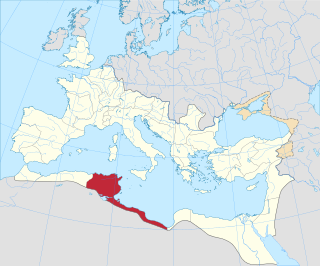| Iubaltiana | |
|---|---|
Africa Proconsularis (125 AD). | |
| Coordinates: 35°40′N10°05′E / 35.667°N 10.083°E | |
| Country | Tunisia |
| Governorate | Kairouan |
| Elevation | 68 m (223 ft) |
Iubaltiana was a Roman – Berber civitas (town) in the province of Africa Proconsularis and in late antiquity in Byzacena. The town has been tentatively identified with ruins near Kairouan in today's Tunisia. [1]

The Roman Empire was the post-Roman Republic period of the ancient Roman civilization. Ruled by emperors, it had large territorial holdings around the Mediterranean Sea in Europe, North Africa, the Middle East, and the Caucasus. From the constitutional reforms of Augustus to the military anarchy of the third century, the Empire was a principate ruled from the city of Rome. The Roman Empire was then divided between a Western Roman Empire, based in Milan and later Ravenna, and an Eastern Roman Empire, based in Nicomedia and later Constantinople, and it was ruled by multiple emperors.

Berbers, or Amazighs are an ethnic group of several nations indigenous mostly to North Africa and in some northern parts of Western Africa.

In the history of Rome, the Latin term civitas, according to Cicero in the time of the late Roman Republic, was the social body of the cives, or citizens, united by law. It is the law that binds them together, giving them responsibilities (munera) on the one hand and rights of citizenship on the other. The agreement (concilium) has a life of its own, creating a res publica or "public entity", into which individuals are born or accepted, and from which they die or are ejected. The civitas is not just the collective body of all the citizens, it is the contract binding them all together, because each of them is a civis.
Iubaltiana was also the seat of an ancient Christian bishopric, [2] governed under the Bishop of Carthage. [3] It was one of several bishoprics in what is today the Kairouan city area.

A cathedra or bishop's throne is the seat of a bishop. It is a symbol of the bishop's teaching authority in the Catholic Church, the Orthodox Church, and the Anglican Communion churches. Cathedra is the Latin word for a chair with armrests, and it appears in early Christian literature in the phrase "cathedrae apostolorum", indicating authority derived directly from the apostles; its Roman connotations of authority reserved for the Emperor were later adopted by bishops after the 4th century. A church into which a bishop's official cathedra is installed is called a cathedral.

Carthage was the center or capital city of the ancient Carthaginian civilization, on the eastern side of the Lake of Tunis in what is now the Tunis Governorate in Tunisia.
Today the bishopric survives as a titular see of the Roman Catholic Church and the current bishop is Luis Manuel Alí Herrera who succeeded Karl-Josef Rauber in 2015. [4]
A titular see in various churches is an episcopal see of a former diocese that no longer functions, sometimes called a "dead diocese".
A bishop is an ordained, consecrated, or appointed member of the Christian clergy who is generally entrusted with a position of authority and oversight.

Karl-Josef Rauber is a cardinal of the Catholic Church, who served as a papal nuncio from 1982 until his retirement in 2009.





